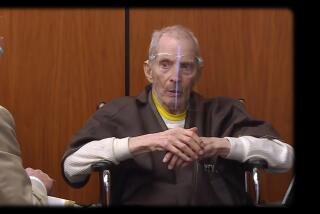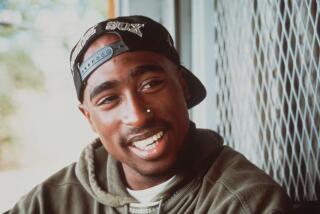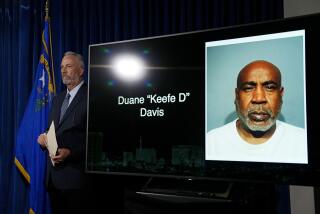But Did the Butler Really Do It?
- Share via
NEW YORK — The TV miniseries may take away Bernard Lafferty’s ponytail, along with his dignity, but it does have this much right--wealth did not bring him happiness.
I last saw the Billion-Dollar Butler just weeks before his death, when he invited me over to tour the mansion he’d bought above Beverly Hills with the settlement he’d gotten for bowing out, once and for all, as executor of the estate of Doris Duke, the woman he’d served and been accused by some of murdering.
His house had grand pianos, crystal chandeliers and oil paintings of scenes from the hunt. In the garage? A white Rolls-Royce.
But Lafferty had not found peace in his palace. He was irked that the gray-suited crowd, which had taken control of Duke’s $1.5-billion estate, was disputing his right to play any role in four charitable foundations set up by the reclusive heiress. They would not give him back a portrait of her he cherished--assuming he’d stolen it, no doubt. Lafferty insisted that, no, Miss Duke hated the thing, wanted to throw it in the trash. He’d saved it in his room back at the old Rudolph Valentino estate, where Duke eventually died in 1993, at 80.
An appraiser said the painting was worth $450. Now the lawyers were churning up thousands in fees arguing over who should get it.
“Miss Duke would have known what to do,” Lafferty fretted, worried that he was failing her yet again.
Then he was dead, at 51, felled on Nov. 4, 1996, by a heart attack right in his palace with the chandeliers and pianos and silver urns.
The funeral in Beverly Hills had Elizabeth Taylor and Peggy Lee in the front row, there to pay their respects, whatever the vultures might say about him.
It was soon after that I got a call from those close to him at the end, his maid and secretary, his lawyer and chauffeur, his private detective too--the infamous Billion-Dollar Butler had all of those--asking for help setting up a seance so they could talk to him one last time. “There is evil forces out there,” said Alban, his dreadlocked Caribbean driver. By then I’d been following the bizarre events for The Times for two years. Why not a seance?
While we must take such exhibitions with a grain of salt--a boulder-sized grain of salt--a sense of theater, at least, requires sharing the last message passed on at the seance. Our medium had the butler warning from the beyond, before the final goodbye, “They’re still going to ---- around with me. Sorry. They’re still going to ---- around with me.”
Which brings us to the miniseries “Too Rich: The Secret Life of Doris Duke,” which airs on CBS on Sunday and Tuesday, four hours in all. “A world premiere event!” Heavily promoted for the sweeps ratings period, it features no less than Lauren Bacall playing Duke on her deathbed looking back at a lifetime of unthinkable wealth, love affairs and loneliness. And it has Richard Chamberlain--the “King of the Miniseries”--playing Bernard Lafferty as . . . the devil.
You need only look at those eyebrows--and they’re hard to miss. Scene after scene, the camera obsesses on those slanted, pointed eyebrows.
Chamberlain, who made his name playing benevolent heroes--on shows ranging from “Dr. Kildare” to “Shogun” to “The Thorn Birds”--has said he relished being able to portray evil in the form of the murderous butler. For four hours, he’s shown as a poisoner, a plotter, a forger and a manipulator--of lawyers, doctors, nurses and Doris Duke herself--whom he plies with overdoses of drugs so he can take over one of America’s great fortunes.
“With a billion-and-a-half dollars in your purse, you couldn’t buy immortality,” he sneers before he offs the poor little rich girl.
The only problem is, Bernard Lafferty was a sweet, wounded man who--for all his flaws and excesses--did none of those things.
So amid four hours for the prosecution, let’s give the butler a few moments of defense. Let’s also give him back his long blond ponytail.
He was an Irish farm boy orphaned in his teens who came to this country after dropping out of school and found work as a waiter, then maitre d’, at a Philadelphia hotel. His Irish accent didn’t hurt, or how he fit well in a tux, but those weren’t the only reason he was able to segue into butling for the rich and famous, including singer Peggy Lee and then Duke. “He was,” said Los Angeles lawyer Charlotte Hassett, who often hit the town with him, “a great girlfriend.”
His enemies later mocked this part of him--saying Duke hired him basically to be her hairdresser--while the TV movie ignores his sexuality. But his brand of gayness was central to his appeal to these women. He’d fuss over their hair, absolutely, or over whether a Ralph Lauren dress could be trimmed into a miniskirt or whether their lipstick was right for their blouse; all the while, laughing--giggling, really--at their smallest jokes. Did he like using Duke’s credit cards to deck himself out along Rodeo Drive, or to buy huge faux-diamond earrings or barrettes for that ponytail? You bet.
“Maybe I look funny to other people,” he said, “but Miss Duke liked me this way.”
She too was a classic eccentric, of course, born in a marble Fifth Avenue mansion to the nation’s tobacco king, Buck Duke, for whom Duke University is named. She long was fodder for the tabloid equivalents of her time, whether in marrying the stereotypical Latin lover, Porfirio Rubirosa, carrying on with a Sunset Boulevard bandleader or adopting as her daughter--then trying to disown--a grown woman she met at a dance class in Hawaii.
As Duke’s whims for people changed, so did her wills.
The miniseries has Lafferty becoming her executor this way: He bribes a lawyer by promising him a lucrative position with the Doris Duke Foundation; personally dopes up Duke--already ailing from a stroke; guides her hand to sign the will; then gloats over the document in his room, cackling in demonic joy.
We certainly must allow some dramatic license--as in moving events to Duke’s home from Cedars Sinai hospital, where she actually signed her final will in April 1993. Even so:
Duke’s main doctor testified that it was the heiress herself who “requested to see an attorney” and that her plastic surgeon, not Lafferty, suggested a firm. The probate lawyer who was called in testified that he worked up the will with Duke herself, face to face, and that she was passionate about eliminating certain people. They went through a series of names, he said, before she insisted on “BL” as her executor.
This was not the first time she anointed Lafferty either. The year before, she ordered a codicil naming the butler and her half-nephew as co-executors. And while challengers to Duke’s last will went to town questioning her state of mind in the hospital, a tape recording documented the phone call in which the heiress--feisty and gossipy--guided her attorney in drawing up that earlier probate plan.
There were several will challenges after Duke died on Oct. 28, 1993, the most fervent led by a New York doctor who had befriended her, gotten her to invest $600,000 in his business and been listed as her executor in 1991. After he was dropped, he blamed Lafferty, “an illiterate, unstable and even dangerous person.” Helping the cause were two former Duke servants, a husband-and-wife cook and housekeeper, whom Lafferty fired. They filed a $30-million suit, along with a series of affidavits alleging that he was a spendthrift drunk--he certainly had those moments--and also a megalomaniac.
The two servants are portrayed in the TV movie almost as heroes, concerned for their mistress and appalled at the butler played by Chamberlain as, well, a megalomaniac.
Nowhere on your screen will you see the servant perhaps closest of all to Duke, who was with Lafferty at her deathbed. Duke’s personal maid, Nuku Makasiale, still can’t forget how Lafferty would wash the frail woman’s hair, and brush it, and hold her hand. It was like a hospital worker’s recollection of how Lafferty stood vigil by Duke’s bed, “deeply affected every time she was in distress, and notably relieved and happy when she was better . . . telling her stories about the dogs, about ‘remember our trip to Thailand?’ Anything to keep her mind off the beeping sounds of intensive care.”
After Duke’s death, Makasiale, the maid, cried not only for her mistress but for the man she called “Bernardo.” As in “Look what they’re doing to Bernardo.”
Duke’s beloved German shepherds are not in the movie. Nurse Tammy Payette is, portrayed as the only nurse treating her at home in her final weeks.
We can grant this dramatic license too, excusing the omission of the five other nurses on the case. Why Payette, though? She’s the one who signed the bombshell affidavit alleging that Duke “did not die of natural causes,” but was done in with intravenous doses of morphine and Demerol.
Payette, we now know, was another victim in all this. Her charges--promoted by the lawyer for the fired servants--drew attention to her own nasty secret: that she had made off with jewelry and other valuables from Duke and a bunch of other wealthy, dying patients.
I spoke to Payette several times right after she was caught pawning some of the loot on Rodeo Drive. Her story would change by the minute.
Last year, from prison--for what it was worth--she signed a new affidavit, recanting her allegations. She now agreed with Duke’s doctors--that this was a dying woman given drugs to ease her last weeks. Yet the murder scenario remains the true one for many who recount the death of Doris Duke.
One character not in the movie is Duke’s primary physician. He discovered last spring that the original script portrayed him, like the probate lawyer, as being coerced into a plot by Lafferty. Citing a district attorney’s investigation into Payette’s allegations, which found no cause of action, the doctor sued for libel, reached an undisclosed settlement--and was written out of the movie.
Lafferty had no such course of attack. Growing heavy and old, far too quick, he died in his sleep months after the settlement that gave him $4.5 million, plus $500,000 a year, for relinquishing any claim to be Duke’s executor or run the foundation named for her.
During his own last days, Lafferty would occasionally ruffle his feathers (“They’re not going to get away with it!”) but more often he sulked.
“I may be surrounded by beautiful things,” he said in his Benedict Canyon home, turned into almost a shrine to Duke, there were so many pictures of her, “but I feel I’ve lost the greatest person ever in my life.”
I was curious whether the actor who played him really thought this man killed that woman.
Cornering Chamberlain at a New York Party
New York Post gossip columnist Cindy Adams had the perfect spot for a party Wednesday night honoring the stars of the CBS miniseries--Duke’s old Park Avenue penthouse. Adams and her husband bought the place from the Duke estate.
You can’t hold an actor accountable for lines scripted by others. But it was a good bet that Richard Chamberlain had thought, seriously, about his character. And it never hurts to ask--you never know what you might get.
A CBS executive is talking about how this could be “the sleeper of the sweeps . . . very strong with women,” when Chamberlain walks in. I guide him to Duke’s old dining room and ask, “Why no ponytail?”
He explains, “At the very last minute, CBS called me and they said, ‘No ponytail, no padding, no diamond earring and no Irish accent.’ They thought they’d turn off their audience. They wanted me to be more recognizable. So I had to find other ways to make him sinister and interesting, which I think I did.”
I ask, “Do you think the man was really a murderer?”
“I suspect he was a hastener of death,” he says.
I explain how I had become Lafferty’s confidant--he’d call from his car, house or a restaurant, just wanting to get things off his chest. I ask, “Is there any thought in your mind that maybe he was the farthest thing from that?”
“Not in terms of this drama. In terms of real life, of course. I didn’t know him. But they had to hang the whole thing on Bernard”--and he laughs--”because everyone else was still alive. They were afraid of being sued.”
I say, “He was one of the sweetest gentlest men.”
“Oh, dear. I play him very sinister.”
I mention the eyebrows.
“Everyone talks about those,” Chamberlain says. “They photographed me rather strangely.”
They did let him cry, once, for the woman he served. He sensed that Lafferty, at some level, wanted to be Doris Duke, even if he was “pulling one of the great swindles of all times--in terms of our drama.”
The film’s Doris Duke has arrived. Lauren Bacall sweeps into the penthouse to kudos from Peter Jennings, Regis, Dick Cavett and others. She looks great.
On the elevator ride down, a man boasts to two friends how he made the A-list event--by feeding dirt about Lafferty to the gossip columns.
As we reach the lobby, the elevator operator, who has been listening in, does something he probably shouldn’t here on Park Avenue--he says something. For years he shuttled Duke and her entourage on this trip. So he pipes in, “The guy was good to that woman. To me, he looked like a man with a good heart, a very humble man. To me”--he holds the elevator open to finish--”they made this guy the fall guy.”
By the way, Lafferty “was good with the money too,” he says--a good tipper. And after Duke died? He showed up in “one gorgeous mink.”
A Different Version of
the Duke-Lafferty Saga
After Lafferty died, I “took a couple of meetings,” as they say in Hollywood, about possibly putting together a Doris Duke-Bernard Lafferty movie. Mine was different from the various “the butler did it” projects floating around town: Odd butler has loving relationship with odd heiress, winds up standing between others and her billion dollars and becomes--the elevator operator said it--the fall guy.
As I saw it, Doris Duke basically killed herself. It was right there in the detailed nursing notes, which traced her decline following a stroke she suffered after having a face lift. Despite warnings from her doctors that more surgeries were risky, she insisted on having her artificial knees replaced. Why? She confided to a nurse, late one night, “her hope to be able to dance again.”
Imagine: the cold, suspicious heiress who wanted one last dance. Two days after the knee surgery, Duke suffered another stroke, the one that sent her toward death. Where did the butler fit in the dance scenario? There was this scene . . .
Nobody quite bought it. The characters were old--not likely to attract the target audience networks relish. No problem, there were flashback possibilities, I said--a young Duke on the beaches of Hawaii . . . Sorry. No sale.
But I’m glad to see the CBS production has Doris on those beaches. In fact, the whole miniseries ends in Hawaii, with Bernard scattering her ashes and Doris talking from the beyond--no medium required.
It’s in her final narration that she explains what happened to her devious butler: “He got the Duke curse, along with that money.”
As I said, that’s right on point. But I do have a final quibble. The voice of Doris reports that, “Upon his death, his entire estate was returned to the Duke Foundation, for charity.”
That sounds like some final justice imposed by others. Not quite. Bernard Lafferty willed that every penny he got go to the causes she favored. Doris Duke’s butler was true blue to the end.
More to Read
Inside the business of entertainment
The Wide Shot brings you news, analysis and insights on everything from streaming wars to production — and what it all means for the future.
You may occasionally receive promotional content from the Los Angeles Times.










